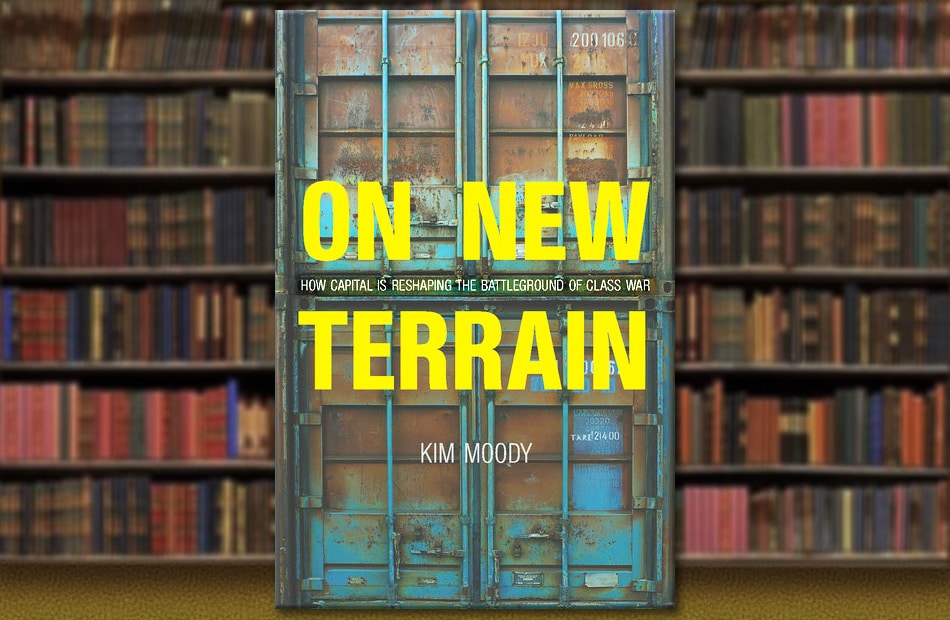Image from Wort
There was a time when the fortunes of the left and organized labor were inextricably linked; when even milquetoast progressives passionately defended unions, socialists worked to radicalize and recruit within the ranks of big labor, and revolutionaries looked first to unions and their members as the base of any future uprising. There was a time when organized labor still had the ability to threaten the power of capital, to wrench real concessions from the bosses, and to shape legislation and national politics. Sadly, those days have passed, and it is no surprise that progressive types and revolutionaries alike have tended to shift the focus of their work further away from the picket line and closer to the ballot box and the street protest. In some ways such a shift makes perfect sense. After all, union density has been falling precipitously for more than four decades and union leaders have, time and time again, in the face of tough choices, almost unanimously betrayed their memberships, ceding much of their historic power for the seeming safety of legislative compromises and political alignment with the Democratic Party. Meanwhile, strike activity has reached an all-time low as rank-and-file union members — and workers more generally — with few real new victories to point to, seem to have lost much of their fighting spirit, falling into defeatist proceduralism and pessimism.
Despite this sobering history, the “battleground of class war,” as Kim Moody describes it in his latest book On New Terrain, is awash in contradictions, and not all is as hopeless as it appears. The shifting nature of capitalist exploitation (the increasing consolidation of firms, the reliance on lean production methods, and the sensitivity of the supply chain), Moody argues, has made it increasingly vulnerable to disruptions from below. Likewise, the super-exploitation of global capitalism and the political betrayal of working people over the last several decades have led to a growing anti-capitalist backlash in which socialist ideas have once again become attractive alternatives. Indeed, if there is one clear takeaway from Moody’s book, it is that working people and their organizations are still the primary agents of revolutionary change and that there is significant potential in the near future for explosive labor uprisings as well as strategic and sustained political movements of working people nationally and internationally.
Moody tells the story of this changing landscape in three parts. The first section of the book focuses on the composition of the working class and describes the major changes in employment and the nature of work since the advent of neoliberalism in the late seventies. The second examines changes in the organization of capital and how such shifts point toward a renewed labor struggle. The third and final section examines the nature of the U.S. political establishment, the betrayal of the Democratic Party, and the potential for independent class politics. Considering Moody’s expertise, it is no surprise that the most original and insightful conclusions are to be found in the first two sections. However, faithful to Marx’s dictum that the point of philosophy is not merely to interpret the world, but to change it, he ends his book with a thoughtful discussion of the way forward that follows logically from the more concrete insights explored earlier.
Kim Moody in an interview with Left Voice in July 2017
See the full interview here
Because the first section is largely concerned with what he calls the “remaking of the U.S. working class,” Moody begins by tackling the twin shibboleths of “outsourcing” and “the precariat,” concepts that he claims are incapable of adequately explaining the seismic shifts in the nature of work and employment over the last several decades. For Moody, the idea that precarious work is to blame for the disorganization and disunity of labor under neoliberalism is grounded largely in speculation and insufficient data. For instance, although there may have been — no surprise — a slight uptick in the overall amount of precarious employment following the great recession, the percentage of precarious workers, according to the Bureau of Labor Statistics, has remained almost unchanged between 1995 and 2005. Furthermore, levels of tenure — that is, the number of years people of a certain age remain within a given job — have also seen little to no increase since the 1980s. In Moody’s view, the important changes affecting working people have less to do with popular ideas of offshoring or precarity and are more about increased work speeds and productivity. That is, the real story of job losses and the decline of the industrial sector over the last thirty years is directly connected to a concerted expansion of labor exploitation.
Despite some documented offshoring, U.S. domestic production has nonetheless been increasing at a steady rate since the 1990s, even as employment in manufacturing has fallen. The culprit behind this loss of employment, claims Moody, is not offshoring, but the introduction of lean production methods capable of extracting greater productivity from fewer and fewer workers. This has in turn contributed to a situation he describes as “the end of good jobs.” As more and more of the labor market shifts toward social reproduction, that is, the maintenance of the very workforce that makes capitalist production possible (such as the preparation of food, childcare, eldercare, education, etc.), wages have been falling and working conditions deteriorating. Such a fall in the standards of living compared to the period before the implementation of lean production methods and the growth of the service sector is exemplified by the rising ratio of real profits to wages, which has increased dramatically since the 1970s. In 1975, for instance, real profits were 21.3 percent that of total compensation, whereas by 2011 that figure had grown to a whopping 35.8 percent. In fact, real profits grew more than 100 percent faster than compensation during that same period. It turns out that great sucking sound that Ross Perot heard in 1992 was not just jobs going south, but money being vacuumed out of the pockets of workers and into the coffers of capital.
These changes in work and working class composition, however, have been shaped by and sometimes overshadowed by the massive changes in capital production and distribution during this same period. According to Moody, the big shifts in capital formation worth noting have mostly to do with the increasing concentration of capital and logistics. A radical increase in mergers and acquisitions have meant a considerable consolidation of capital, while the proliferation of just-in-time supply chains have likewise led to the concentration of massive nodes, or what Moody calls “logistics clusters,” which are extremely vulnerable to strike activity. Of course, such arguments fly in the face of the popular consensus that U.S. firms in particular have become more diversified, flexible, and adaptable, and that labor has become more fragmented and thus weaker. The fact is that, thanks to intense competition, many U.S. firms are actually more vulnerable than ever. As Moody explains:
The overall picture of the context in which the U.S. working class has taken shape since the early 1980s began as one of decentralized production via outsourcing, increased precarious work, and the experience of fragmentation. As is so often the case in the expansion of capital accumulation, however, the reality of competition has produced an opposite tendency in the increased concentration and centralization of capital in almost every realm of the production of goods and services. As part of this process, more and more aspects of production are tied together in just-in-time supply chains that have reproduced the vulnerability that capital sought to escape through lean production methods and relocation.
Competition, in other words, has caused firms to seek greater and greater market shares and efficiencies of scale, as well as greater advantage and leaner production through the use of capital intensive technologies. This has in turn meant that fewer and fewer firms face fierce competition from rivals whom are themselves already “all in,” as it were. Such competition, as Marx made plain, inevitably leads to greater exploitation of labor. And this increasing exploitation is clearly evidenced by the vast gap in productivity versus wages over the last several decades, in which productivity has gone up by more than 150 percent even as wages for nonsupervisory production workers have remained more or less flat.
Such changes, however, are not without a bit of silver lining. As Moody explains, the intensification of capital, particularly the capital-to-labor ratio (that is, the amount of capital invested per worker), can make firms more vulnerable to work stoppages, slowdowns, or strikes for better wages and working conditions. And this vulnerability is dramatically exacerbated by the nature of contemporary logistics chains. As Moody notes, there are at least 4 million workers directly involved in the logistics and transportation sector, all of which have the capacity to threaten or inflict significant profit losses. And such power is not merely a means of winning concessions or wage increases, but is a source of real revolutionary potential. A coordinated strike of even just a portion of these 4 million workers could bring an entire city, or the entire economy to its knees in a matter of days. This is in part why Moody sees an increasing possibility of a massive labor uprising or what he calls “the coming upsurge.”
Of course, Moody is not so foolish as to predict when and how such an uprising will happen. Instead, he argues that we should prepare the ground through the establishment and development of a politically-minded, socialist, “militant minority” of union and working-class activists who are capable of pushing the larger activist layers toward more radical conclusions and actions. He sees the possible beginnings of such a layer in the many growing rank-and-file reform movements of the past decade as well as the work of militant, activist-driven labor actions by the Communication Workers of America (CWA), National Nurses Union (NNU), and the Chicago Teachers Union (CTU), all three of which have staged powerful and often successful strikes or strike threats in recent years. Furthermore, according to Moody, the development of this layer — and its power — is increased by the high concentrations of often low-wage logistics workers in large urban centers as well as the growing public support for labor unions. According to Gallup, support for labor unions was 58 percent in 2015 and 61 percent in 2017, up dramatically from an all-time low of 48 percent in 2009.
Just as these massive changes to work and production have produced a complex set of possibilities for working people, Moody illustrates how the current political climate is also distinguished by a series of incredible contradictions and new possibilities. Although the historic abandonment of working class people by the Democratic Party (particularly those in the devastated rust belt) paved the way for the rise of a Trump presidency, it also sowed the seeds for the insurgent Sanders campaign, itself an expression of the great unhappiness and discontent among the U.S. working class. And although the Sanders campaign was brutally crushed by the Democratic National Committee, the number of working people — especially young working people — who have turned to socialism (in one form or another) or are open to socialist ideas has increased dramatically.
For Moody, this changing political terrain can be explained by three major interlocking developments: the continued dominance of the neoliberal state model and the increasing influence of capital over politics; the rise of the Republican Party at the state level; and the right realignment of the Democratic Party. Although many others have written eloquently about these issues, Moody’s contribution is a connection to the larger shifts in the workplace and the structure of capital in the 21st century. The result is a damning portrait of the absolute failure of American politics (and American capital) to address even the most basic negative effects of capitalist production.
Aided and sometimes even promoted by state and local governments, the new neoliberal consensus has effectively made many states entirely subservient to the whims of enterprise even as the federal government has been increasingly captured by corporate and billionaire campaign contributions. Indeed, according to Moody, the state has not only been compliant, but, at times, actively complicit “in the destruction of living and working standards and the undermining of organized resistance through legislation, court rulings, and just plain force.” Meanwhile, corporations have used threats of relocation, domestic outsourcing, and other forms of economic blackmail to extract, as of 2012, more than $80 billion each year from states in tax breaks and incentives. One need only look at the recent fierce state competition over the new Amazon headquarters to see that such practices are still alive and well. Endemic corruption has effectively reduced many state parties to little more than technocratic money machines with little to no real activist base and thus made them potentially vulnerable to what Moody calls “well-organized mass grassroots human intervention.”
This vulnerability, however, does not mean the Democratic Party can just be taken over and used for the benefit of the proletariat. Indeed, Moody saves his most trenchant critique for the Democratic Party and those leftists and socialists who still believe that they can somehow capture or use the party for their own ends. As he painstakingly details over several chapters, previous attempts to realign the party or move it to the left (from Michael Harrington’s Democratic Socialists to Jesse Jackson’s Rainbow Coalition) have failed completely. Rather than splitting or turning to the left, the Democratic Party has tacked further and further to the right even as it has become more ideologically disciplined. In the 1960s, for instance, party-line votes in the House and Senate ranged from 51 to 58 percent, while over the last two decades that number has increased to an extraordinary 90 percent — displaying more discipline than exists in most democratic centralist organizations. The argument, popular among many DSA members and others on the soft socialist left, that the Democratic Party is just an empty shell to be used to run candidates, or that a portion of it can be split off into a workers’ party, is nonsense. Not only is it near impossible to run in primaries against incumbents without the support and wealth of the bigger party structure, but winning on a Democratic Party ticket inevitably leads to exile from or co-optation by the party (the list of once-radical Democrats that have sold their soul to the party is a very long one). Furthermore, to think it is possible to direct average voters out of the party without first building an alternative for them to turn to makes little sense.
In place of these strategies, Moody proposes instead that socialists and leftists prioritize the formation of a new mass party grounded in popular movements of workers and the disenfranchised willing to “go beyond conventional social democracy.” Drawing on examples from the Richmond Progressive Alliance and Socialist Alternative member Kshama Sawant’s successful campaigns for Seattle City Council in 2013 and 2015, Moody argues that local, movement-supported campaigns can both win office and deliver significant gains to working people, while simultaneously building upon and supporting grassroots forms of organization. Although such local victories can be the catalyst for bigger movements, Moody argues that to win more than a few local seats, the left will also have to tap into and help build the kinds of worker-based militant struggles and unionization efforts capable of mobilizing the millions of left-leaning non-voters that exist in large cities across the country. Indeed, for Moody, because of the vast convergence of low wage service and logistics workers, as well as the lack of political competition (many large cities are now dominated by the Democratic Party), large urban centers like New York and Chicago are potential tinderboxes of revolutionary activity, founded on what he calls “sustainable, dense, overlapping grassroots networks capable of bringing companies, industries, and cities to a halt when needed to disrupt ‘politics as usual.’”
On New Terrain is probably one of the most important and useful works on the state of U.S. capital to come out in years. However, it is disappointing that a text of such wide-ranging intelligence and dialectical insights would have so little to say about the massive changes to production and organization that is sure to be caused by climate change over the next several decades. That these changes will hit large urban centers the hardest suggests that further discussion of the impact of climate change and its effects will have to be an essential part of any consideration of the path of future struggle. Despite this, Moody’s close analysis of the changes to production and worker organization, as well as his trenchant analysis of the weak spots of the American political system, are an enormous resource for those on the left looking to understand both the challenges and the prospects for revolution in the new century.











